How to Brush Your Teeth: For Kids
Disclosure:
Ask the Dentist is supported by readers. If you use one of the links below and buy something, Ask the Dentist makes a little bit of money at no additional cost to you. I rigorously research, test, and use thousands of products every year, but recommend only a small fraction of these. I only promote products that I truly feel will be valuable to you in improving your oral health.
If you’re reading an article called “How to Brush Your Teeth for Kids,” my guess is that your little ones are ready for some serious oral hygiene. You made it through the first few months of child rearing and think you have it down…Then, that first little tooth appears.
“What do I do?” you ask. How do you keep that little pearl of a tooth clean and cavity-free?
In this article, we’ll cover both when and how to brush your kid’s teeth (correctly, that is). But even more importantly, I’ll talk about the way to instill brushing in your child’s mind as a fun, lifelong habit.
Plus, I’ll break it down by age, since a two-year-old needs a different approach than a 12-year-old.
Just want the age-specific advice? Click the appropriate button below to skip down.
0-2 years old 2-8 years 8+ years
How do I look after my child’s teeth?
Before we get into the “how” to brush your teeth for kids, let’s define what it means to look after your child’s teeth.
Why? Because brushing part is secondary to something much more important:
How your child learns to brush now affects your child’s relationship with dental health for the rest of their life.
Sound dramatic? It’s not. I’ve seen kids come into my office traumatized just because of what the toothbrush signified at home.
Here’s what you don’t want: You don’t want the toothbrush to come out and for your kids to want to run away from this thing that invades a sensitive part of their body. Sadly, there are many kids that think, “Hey, this is a fun game where my parents really want me to do something! I’ll run away and make it torture for them.”
I believe you can’t force anyone do anything—especially kids.
The idea is to teach the “how to brush your teeth: for kids” lesson in such a way that makes it fun! Your little one is much more likely to love their brushing habit if it brings joy to his or her day.
Clearly, it’s important to get this right. Here’s another piece of encouragement: It’s okay to sacrifice a “perfect” brushing job in order to make the experience really positive for your kids. If it means getting it right one day, it’s worth it.
While technique matters and should be developed over time, the experience is what matters most at first. Ideally, you’ll also be using supplements to heal cavities alongside with these brushing habits (and keeping your child’s regular dental appointments). Those are just a couple of ways you can both protect your child from cavities while also giving them a lifelong lesson in the best brushing habits.
The way to do this is to make sure your kids see you brushing (and having a blast!) 2-3 times per day. This is key to creating a positive experience that’s also part of every day’s routine.
You want your child to come to expect brushing in the same way they expect dinner time or bathtime or storytime before bed. Consistency is key—you should begin as soon as the first tooth appears at around six months, but if your child is older, it’s never too late to start.
Above all else, aim to make brushing your child’s teeth a pleasurable experience so it becomes a habit your child takes into adulthood.
Brush in front of them, 2-3 times a day, when you brush.
This Confucius quote perfectly describes why you should first brush your own teeth in front of your children before expecting them to let you do it:
By three methods we may learn wisdom: First, by reflection, which is noblest; Second, by imitation, which is easiest; and third by experience, which is the bitterest. -Confucius
A baby isn’t capable of self-reflection or the understanding of why brushing even matters. If you force them to experience brushing before they perceive it as a positive habit, it might bring on tears and fear.
But when you set an example of brushing your teeth as a fun, enjoyable event, they can imitate you with anticipation. Some children may even beg for their turn to try it!
Tap dance, crack jokes, do whatever it takes to convince your child that this is a normal and fun daily routine. Just as dinner is a family activity, you can make brushing a time when the family gathers in the bathroom to brush after a meal.
This is great when your child is just starting to brush their first tooth, between 6-12 months of age.
Already past the one-year mark and worried you started off teaching brushing on the wrong foot? There’s no shame here! Parenting is hard, and knowing your child needs to brush can be frustrating when your request is always met with complaint.
If your child hates brushing his/her teeth because of early encounters, take some time to back off forcing the habit and start fresh. Begin a new routine and allow your child to warm up to brushing with a new perspective.
Put on a show.
Have one parent brush the other parent’s teeth.
Let your kid brush your teeth! (good luck, and make sure you don’t grimace!)
Have your kid brush the dog’s teeth…and wash your hands thoroughly afterwards.
This is what I used to do with my three daughters: I’d brush my teeth in the car and hum a little tune (while my wife was driving, and without toothpaste). Stereo blasting, my wife and I would dance around the living room while brushing.
The kids saw me brushing all the time, consistently, and it always looked fun.
In the end, our kids do what we do (scary, I know—but this is what I’ve learned after being a dad for 30 years). Brush and floss in front of and with your kids!
Bonus: your own oral health will get a great boost at the same time.
Keep it positive. Never resort to fear tactics.
I’m a parent, too. I get it. You better believe I’ve resorted to threatening the kids when they just…wouldn’t…listen.
But playing hardball can result in resentment and even dental phobia later on in life, which is still quite common. In fact, over 50% of the population seeks dental care only when they are in pain.
This leads to more costly dental procedures because most things in dentistry need to be caught early and treated or reversed—waiting almost always is the worst thing to do!
The worst thing to do is threaten your child while teaching how to brush your teeth for kids. Beyond all, please don’t use the dentist as a threat. This will paint dental visits as a big, scary punishment, which isn’t a good precedent to set.
How to Brush Your Kid’s Teeth: Step-by-Step Instructions
As I said above, I urge parents to focus more on making brushing a habit rather than obsessing over a perfect clean.
So, let’s say you’ve got that first part down pat. Your baby or child is brushing on his/her own and expects brushing time as part of the routine, 2-3 times per day. They brush first, and then it’s your turn to get in there and brush their teeth thoroughly.
But…how do you do that part, exactly?
Gentle, gentle, gentle
Many adults think their teeth aren’t clean without a firm, strong brush. Actually, that’s a misconception! Gentle is better for teeth of all ages. You’ll get your kids’ teeth clean if you’re very gentle, without risking creating tiny abrasions on teeth that can play home to acid-causing bacteria that lead to cavities.
Plus, they’ll let you brush for longer!
Pinch the handle between two fingers to ensure a light grip.
Use a wiggle motion, not back and forth
Think tiny circles, or little wiggles that mimic what an electric toothbrush would do (not back and forth).
Aim for the gums
Aim for the gums at a 45 degree angle down from and up into the gums.
Focus on brushing three surfaces
Aim to get all three surfaces of the 3D structure of the tooth: outer, inner, and chewing surfaces.
How to brush with an electric brush:
The same technique applies, with some important changes:
- Still cover inner, outer, and chewing surfaces, and don’t wiggle or go back and forth. Just let the brush’s motion do its thing, holding the brush at a 45 angle with the gums
- Apply gentle pressure, make sure not to bend the bristles.
- Make sure bristles are at least half on teeth.
Brushing my kid’s teeth is impossible. How am I supposed to do this 2-3 times a day?
The thing I notice most, especially in new parents, is that they’re making it too difficult. Here are my tips for making it easier on you.
1. Don’t be in a rush
Always brush when you’re not in a rush!
The guideline is two minutes for brushing, but at young ages, aim for four to five minutes—or longer, if your kid is having a lot of fun!
If you go 4 minutes, it’s more likely your child will have a solid two minutes worth of good brushing.
2. Lose the toothpaste
Don’t let toothpaste limit when and where you brush. Toothpaste can make kids want to gag or need to spit, and can make things unnecessarily messy, especially when they’re young.
I’ve found that toothpaste will make parents less likely to brush their kids’ teeth. It just means they have to go into the bathroom with a bottle of Windex to wipe down the sink afterwards.
Dry brushing is just as effective, in most cases, as brushing with toothpaste. That means you can even do your brushing dance in the car, the waiting room, or anywhere else you have a few extra minutes with your little one.
If your child is the kind who’s motivated by toothpaste, here’s my recommendation for the best baby toothpaste.
Keep in mind that, according to the CDC, most kids are using way too much toothpaste. If you choose to go with a fluoride toothpaste, make sure that your baby is getting just a sliver of toothpaste. Even adults should never use more than a pea-sized squeeze.
That being said, I recommend fluoride-free toothpaste…Check out my fluoride facts article if you want to know more on that.
3. Get in front of the mirror
Have you tried sitting your child on the closed toilet seat and going for their teeth with a brush?
Probably didn’t go too well, huh?
Instead, have your child stand at the mirror while you brush his/her teeth (or assist, depending on the age) from behind while you both look into the mirror. This lets your kiddo see exactly what’s going happening. Plus, looking in the mirror makes it easier to do little dances, songs, and games.
Sitting on the toilet is for other activities. 🚽 Don’t associate it with cleaning teeth.
4. Use music
Put a speaker in the bathroom to play your child’s latest favorite song. Better yet, just choose a song to brush to!
My daughters loved “Brush Your Teeth” by Raffi. In fact, my oldest uses it with her toddler for brushing time. (It’s adorable, as I’m sure you can imagine.)
Here’s our favorite, plus a few more fun songs your child might love:
5. Use an hourglass
I recommend an hourglass rather than a digital timer for timing brushing. Most kids under the age of seven are very kinesthetic and an hourglass gives a tangible concept of how much time is left to brush.
An hourglass also can’t be manipulated like a digital timer can.
Try this easy sand timer to teach how to brush your teeth for kids.
Common Mistakes
Here are two of the most common mistakes parents might make when starting a new brushing habit with their kiddos. (If you’ve done these, don’t fear—don’t be afraid to start over and make brushing fun again!)
Don’t lie them down to brush
If you can, try something for me…grab a bottle of water and lie down flat on the ground. While lying flat, take a drink of water.
You can get the drink down, but it probably made you feel like you had to gag a little.
Now, think of what that might feel like to a baby or toddler who can’t clearly communicate what they’re experiencing.
Always brush in an upright position. If you have to lie your child down to force them to brush, it’s not worth the brushing.
Don’t use gauze
You may have read in baby books that you should use gauze to rub or wipe your baby’s new teeth. This is a waste of time. It confuses the child, it’s not effective, and it tastes terrible (cottonmouth, yuck!).
It also wastes precious time to teach your child the proper way to brush. Get them used to the routine of brushing 2-3 times a day before they have the chance to form an opinion.
Age-Specific Advice
babies 0-2 years old
What parents need to know
- At this stage, it’s all about making brushing fun
- Use a brush with extra soft bristles (babies tend not to react kindly to being poked in a sensitive area with hard bristles)
- Get baby used to the routine of brushing 2-3 times per day
- Let your baby brush first, then go in afterwards (as long as the baby is enjoying the experience)
When should I start?
Start brushing your baby’s teeth as soon as you see the first tooth appear. It’s okay to gently massage the gums with the brush, too.
How do I choose a toothbrush for my baby?
A baby toothbrush should…
✅Have soft bristles: Babies have extra sensitive gums. Their first experience is important—if they feel tough, rough bristles poking sensitive gum tissue, you better believe they’re not going to want to do that again.
✅Be designed for babies, not kids: A kid’s jaw anatomy is such that even if they open wide, the big head of even a toothbrush designed for kids will bump into the ramus, the piece of bone that sticks out. You need a tiny toothbrush for a tiny mouth.
✅Be manual: Again with the sensitive hearing—make sure your baby’s first exposure with brushing is positive. Imagine a loud electric toothbrush coming at your baby for the first time—it’s going to be scary! Stick to manual.
My picks for baby toothbrushes:
best for baby grip
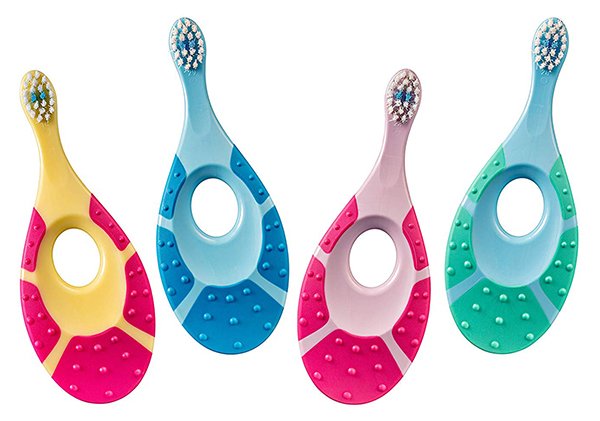
Jordan Step 1 Baby Toothbrush
This brush is fun and easy for even small babies to hold onto during brushing.best for several teeth

Baby Buddy Brilliant Baby Toothbrush
Try the Baby Buddy when your little one has several teeth that need brushed on all surfaces. The 360-degree angle is perfect for no wrist twisting.Toddlers & Young Kids: 2-8 Years Old
What parents need to know
- Parents should brush the child’s teeth every time until the age of eight
- Let your child brush themselves at each session, and then you go in afterwards
- Pro-tip: get plaque-disclosing tablets and use those a few times. Kids at this age get so many tangible chores—putting toys away or getting their shoes on. Using a plaque-disclosing tablet lets kids actually see the results of their work when they brush their teeth. (This is perfect for kids who enjoy games!)
How should I choose a toothbrush?
✅Have soft bristles: Kids have extra sensitive gums. Soft bristles are extra important since kids this age don’t have great technique, and abrasive bristles especially can do damage, even gum recession. Look for “extra soft” on the packaging. I also like to do a “thumb test,” where I press on the brush head with my thumb to make sure the bristles feel super soft.
✅Be designed for kids, not adults: An adult-sized toothbrush head will cause gagging and will be too big to get into the little spaces in smaller mouths.
✅Be manual: Many people don’t know this, but kids electric toothbrushes can cause damage if used incorrectly. I recommend you start with manual first, get comfortable with it, and only then consider introducing an electric brush (slowly).
When should I introduce an electric toothbrush?
If the family budget allows for it, a child ideally gets both a manual and an electric brush. A manual toothbrush will reinforce the habit and do quick brushes on the go, and the electric can do a good job clearing plaque before bed and first thing in the morning.
The basic standard for when to start is this: If your child is comfortable with it (and maybe excited!), then it’s a good time to try it out.. This will also be easier on you as a parent. But it can go south quickly with one bad experience. Don’t be afraid to go slowly!
My picks for small child toothbrushes
best manual kids' brush
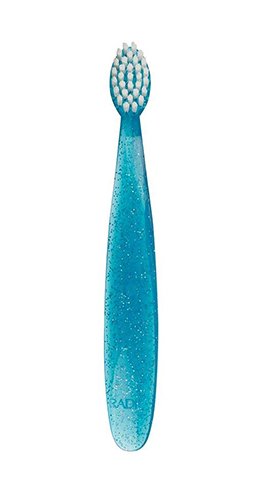
Radius Totz
Eco-friendly and ultra-gentle, this is my #1 pick for a child-sized manual brush.best electric kids' brush
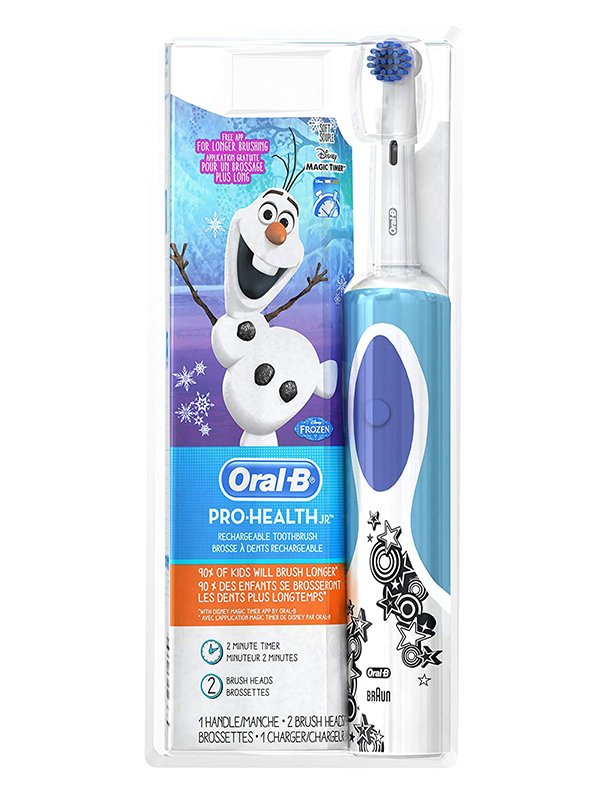
Oral-B Kids Electric Toothbrush
This high-quality rechargeable brush uses oscillation to break up plaque from kids’ starchy diets.While battery-powered electric toothbrushes for kids are cheaper, the rechargeable ones are much higher quality.
Plus, I love Oral-B’s oscillatory motion for young kids, since it does a great job breaking up plaque that can build up when children eat a lot of starchy foods.
best companion smartphone app
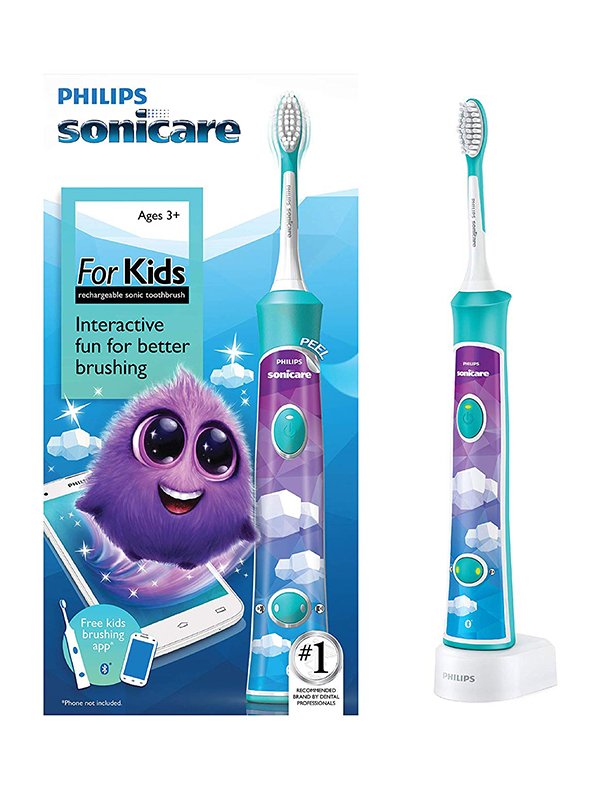
Sonicare for Kids Electric Toothbrush
Sonic vibrations don’t work for many kids, but this brush has a great companion app.
I usually opt for oscillatory instead of sonic for young kids, since sonic vibrations can freak kids out. I’ve found in my own patients and kids that sonic vibrations are often too much for sensitive ears and mouths. However, this Sonicare comes with an app that’s highly recommended by parents.
Ages 8+ Years
What parents need to know
- Age 8 is when you let your kid fly solo—they now get to brush all by themselves!
- During later childhood, the biggest problem with brushing is often keeping the habit
- I still recommend supervising brushing and brushing together as frequently as you can
- Be diligent about following up to make sure your child is still brushing 2-3 times a day for at least two minutes
My picks for older child toothbrushes
The electric brushes I recommend for children 2-8 years old will still work great for your 8-year-old. At around age 12, it’s probably time to graduate to an adult brush.
The requirements here aren’t as specific as for younger kids—but I still urge you to stick with soft or ultra-soft bristles (that goes for adults, too!).
best travel manual brush for ages 12+
best electric brush for ages 12+
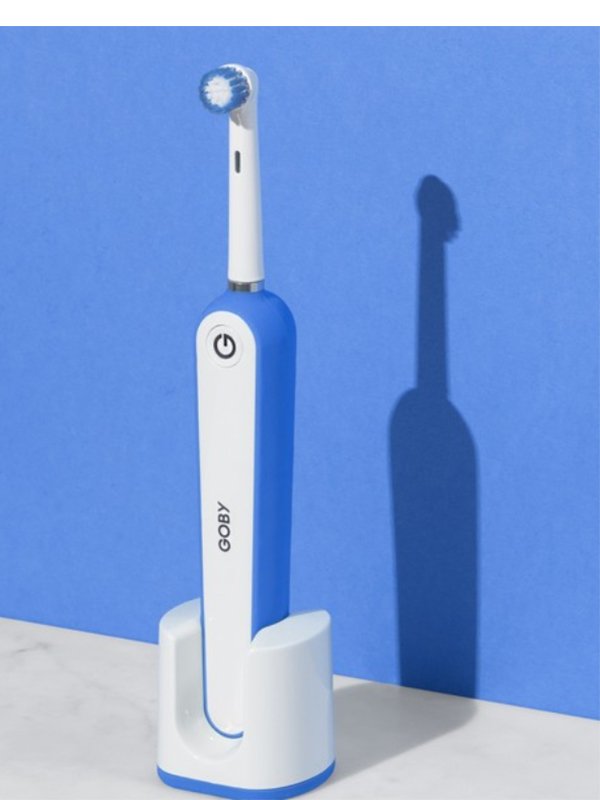
Goby Electric Toothbrush - Classic Blue
I love the Goby for its oscillation and color selection. Plus, it’s a subscription, which = no forgetting to replace brush heads.10+ Tips for How to Brush Your Teeth For Kids From Other Parents
I asked my readers who are parents what works for them. This is what they (you) said:
I love the firefly toothbrushes with flashing lights. We turn off the lights in the bathroom and then brush until the lights turn off.
Baby bum on YouTube. We’re generally no screen time, but I’ve decided dental health is more important than 1 min of video a night – same works for nail clipping.
I look for characters or animals to clean, is Mickey back there? She tells me who is back there sometimes. Lots of praise. I also let her brush first then I do the rest.
Kids electric toothbrush plus episode of Elmos World on the phone ==success since age 2.
I let him brush mine then we take turns.
Baby electric toothbrush so it sounds like mine. Sometimes we do it together. Sometimes when he’s getting a diaper change and is bored.
We used to sing songs and then when that stopped working we would tell a story about a princess who had to brush her teeth twice a day or else try would turn green due to an evil spell she had put on her. We wouldn’t sing or tell the story unless we brushed the teeth while telling/singing it. Worked for months.
The Sonicare for Kids toothbrush with bluetooth app has been great since age 4 for teaching proper technique and making it fun for my kiddo. She’s 5.5 now and brushes for 2 minutes 2x/day, mostly without the app.
With my kids I kept explaining why we need to brush our teeth, I tried different toothpaste so they could be excited about it, I invented a song that my 5 year old still sing and last thing is to be patient, at one point, they all brush their teeth 🙂
I Make the sound eeeeeee for brushing front teeth and aaaaaaaaaa for the back teeth. Also I’m brushing my teeth while daddy brushes babies teeth.
We use a 2 min sand timer we got from the dentist, kids think it’s a game to brush as much as they can before the sand runs out.
This app changed my life:
I tell my kids we have to get the cavity monsters out…”Oops! I missed one! Got it!” It works! My almost 2yo is into it and has been since the start, 4yo brushes w/ no problem (same method), and let’s me have a turn too (to double check for monsters he might’ve missed;). Then “cheeeese” (front teeth) and “tongue”. Done. Side note: My kids are not afraid of monsters. They think they’re silly. Maybe this is why?
The Chompers podcast is amazing for this. https://www.gimletmedia.com/chompers
My child has disabilities that make tooth brushing difficult. What should I do?
It can be challenging to brush a child’s teeth when they have trouble understanding the “why” and might not be able to participate in the fun methods I suggested above.
Here are a few pieces of advice I would give to parents of children with disabilities to teach how to brush your teeth for kids:
- Try to link the act of brushing to another activity or motivator that your child enjoys doing every day. This will link brushing to something positive.
- To introduce some fun and games into the routine, try using plaque-disclosing tablets that will color areas of teeth with plaque. Brushing to get to pearly white again can be a fun and very easy-to-understand game—make sure to do it in front of a mirror.
- Take very small steps and don’t expect too much in the beginning. It’s hard enough to learn good brushing habits without a disability, so don’t be hard on yourself or your child if things move slowly at first.
- Keep up with six month cleaning appointments at your dentist. If one is available in your area, look for a pediatric dentist that specializes in treating children with disabilities.
- Focus on prevention with other methods. If you’re able, avoid feeding your kiddo lots of processed carbohydrates and sugars. Preferably s/he will eat all or mostly whole, unprocessed foods and no sugar except the sugar alcohol xylitol, which can actually benefit oral and dental health.
- Use an electric toothbrush. An oscillatory brush like the Oral-B I linked to above will be best at getting rid of plaque, particularly if your child won’t often sit for a full two minute brushing session.
While it can be a frustrating experience at first, remember that you’re giving your child with a disability a gift by teaching them how to brush for kids. Hang in there! It will get better.
What to do when brushing isn’t going well
Let’s face it, all kids are pretty bad brushers. That’s why you have to get in there and do it for them at every session until age eight!
Plaque disclosing tablets are very effective for kids who don’t want to brush—it takes an abstract thing and makes it concrete.
But, let’s say you’re still getting your baby accustomed to the new brushing routine. Or maybe your child is going through a brushing strike.
There are a million good reasons why parents might not be able to brush their teeth all the time.
That’s why I recommend supplementing for all babies and kids.
What supplements do is make sure that your child’s teeth have the minerals available to aid in the remineralization process. If small cavities do happen, the mouth has a better chance of healing it by itself when aided by supplements.
There will be plenty of times when your child flat out won’t let you brush, and supplementing plans ahead for these moments so there’s good nutrition already on board to fight cavities.
Cod Liver Oil: Rich in vitamins A, D, and K2, fermented cod liver oil. This one comes in a lemon flavor that your child won’t mind if you get them used to it as babies. For older kids, you can mix it in to anything—applesauce, oatmeal, etc.
Oral probiotic: The strains in PRO-Kids ENT work to support the balance of the flora in the oral cavity and allow room for the good bacteria to thrive. The probiotic S. salivarius M18 produces an enzyme that helps dissolve and loosen the formation of biofilm and sticky deposits around the teeth.†
In fact, M18 colonization in the mouth often leads to better dental scores. PRO-Kids ENT can help reinstate microbial balance for your little one (this is particularly important after antibiotic use). This may lead to less days off school and, of course, missed work for parents looking after children who don’t feel their best.†
Final Takeaways
- Habit formation is more important than getting in a good brush—take the time to make brushing fun!
- Kids just aren’t great brushers because it takes years to have good enough coordination to get the technique down. Make sure you’re supplementing with cod liver oil and an oral probiotic as soon babies start solids.
- To make it easier on yourself, lose the toothpaste, brush when you’re not in a rush, and brush anywhere—no need to limit it to the bathroom!
†These statements have not been evaluated by the food and drug administration (FDA). These products are not intended to diagnose, treat, cure or prevent any disease.
The post How to Brush Your Teeth: For Kids appeared first on Ask the Dentist.
from Ask the Dentist https://askthedentist.com/brush-your-teeth-for-kids/



Comments
Post a Comment